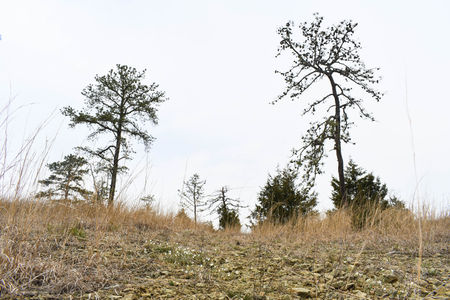Serpentine Barrens: Difference between revisions
| Line 31: | Line 31: | ||
===Flora:=== | ===Flora:=== | ||
[https://en.wikipedia.org/wiki/List_of_wildflowers_of_Soldiers_Delight/ List of Wildflowers at Soldiers Delight] | [https://en.wikipedia.org/wiki/List_of_wildflowers_of_Soldiers_Delight/ List of Wildflowers at Soldiers Delight Serpentine Barrens] | ||
[https://en.wikipedia.org/wiki/List_of_woody_plants_of_Soldiers_Delight/ List of Woody Plants at Soldiers Delight] | [https://en.wikipedia.org/wiki/List_of_woody_plants_of_Soldiers_Delight/ List of Woody Plants at Soldiers Delight Serpentine Barrens] | ||
[https://en.wikipedia.org/wiki/List_of_ferns_and_fern_allies_of_Soldiers_Delight/ List of Woody Plants at Soldiers Delight Serpentine Barrens] | |||
===Threats and Restoration Efforts:=== | ===Threats and Restoration Efforts:=== | ||
Revision as of 11:20, 3 May 2021

Serpentine Barrens are unique ecoregions that can be found globally, in small patchy pockets of land with serpentine bedrock and soil. The term "serpentine barren" generally refers to a serpentine outcrop and its associated vegetation. These habitats are notable for their distinct vegetation with high rates of endemism. The difference in vegetative communities is the product of chemical, physical, and biotic edaphic factors but is primarily driven by the toxic chemical composition of the serpentine bedrock and soil. These systems are used to study edaphic endemism and plant speciation. [ ] They are also used as an analog to brownfields in restoration ecology because of the high heavy metal content in the soil. [ ]
Rock formation:
Serpentine is not the name of a single mineral. Instead it is a name used for a large group of minerals that fit this generalized formula: (X)2-3(Y)2O5(OH)4.
In this formula, X will be one of the following metals: magnesium, iron, nickel, aluminum, zinc, or manganese; and, Y will be silicon, aluminum, or iron. The appropriate generalized formula is therefore as follows: (Mg,Fe,Ni, Mn,Zn)2-3(Si,Al,Fe)2O5(OH)4.
Chrysotile, antigorite, and lizardite are three of the primary serpentine minerals. There are many other serpentine minerals, most of which are rare.
Serpentine minerals form where peridotite, dunite, and other ultramafic rocks undergo hydrothermal metamorphism. Ultramafic rocks are rare at Earth's surface but are abundant at the oceanic moho, the boundary between the base of the oceanic crust and the upper mantle.
They are metamorphosed at convergent plate boundaries where an oceanic plate is pushed down into the mantle. This is where they are subjected to hydrothermal metamorphism. The source of water for this process is seawater entrained in the rocks and sediments of the oceanic slab.
During hydrothermal metamorphism, olivine and pyroxene minerals are transformed into or are replaced by serpentine minerals. Some of the metamorphic rocks produced here are composed almost entirely of serpentine minerals. These serpentine-rich rocks are known as "serpentinites."
Extensive areas of Earth's surface are underlain by serpentinites. These areas occur near present or ancient convergent plate boundaries. They are locations where remnants of an oceanic plate is exposed at the surface. The remnant portion of the plate was either thrusted up onto land, accreted onto the edge of a land mass, or exposed by uplift and deep weathering.
These areas of exposed oceanic plate are known as ophiolites. They are often the source of valuable minerals that might include magnetite, chromite, chrysoprase, jade, and serpentine. Article by: Hobart M. King, PhD, RPG []
Evolution and soil edaphic endemism:
Vegetative communities growing in serpentine barrens differ from surrounding areas by having a notably distinct physiognomy and community structure, high rates of endemism, low species richness, a dominance of specific taxa, a predominance of xerophytic species, low productivity, and the co-existence of high and low ph-tolerant species.
East Coast Serpentine Barrens:
Add map of barrens. Briefly describe history + formation
Flora:
List of Wildflowers at Soldiers Delight Serpentine Barrens
List of Woody Plants at Soldiers Delight Serpentine Barrens
List of Woody Plants at Soldiers Delight Serpentine Barrens
Threats and Restoration Efforts:
Invasive species, fire